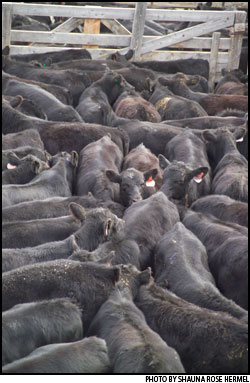
Dillon Feuz
In the Cattle Markets
There are two key factors that determine the profitability of all retained ownership alternatives. The first is the direction of the market during the retained ownership program. If the overall market level moves higher, producers are almost sure to make money. Conversely, if the market level moves lower, producers are almost sure to lose money. Now don't expect me to be very good at telling you which is going to occur.
 The other key factor is the overall cost per pound of gain in the program compared to the overall feedlot cost per pound of gain. If you can add weight cheaper outside of the feedlot, you can frequently see a positive return to do so.
The other key factor is the overall cost per pound of gain in the program compared to the overall feedlot cost per pound of gain. If you can add weight cheaper outside of the feedlot, you can frequently see a positive return to do so.
The reason this relative cost of gain is so important is that feeder cattle prices are determined primarily by the expected cost of gain in the feedlot and the expected fed-cattle price. Consider the following example: For the week ending Nov. 28, 2009, the following prices were observed at Nebraska auction markets: 750-pound (lb.) steers, $99 per hundredweight (cwt.), $743 per head; 550-lb. steers, $109 per cwt., $600 per head. The added value for 200 lb. was $143 per head, or about $0.715 per lb. ($143 ÷ 200). Data Transmission Network (DTN) estimated the total cost of gain to be about $0.71 per lb. for the same time period.
Here is another approach that results in the same type of conclusion. In the middle of November, June live-cattle futures were trading at $85 per cwt. For a 1,300-lb. fed steer, that would be an expected gross return of $1,105 per head ($0.85 ✕ 1,300 lb.). If the cost of gain in the feedlot were expected to be $0.69 per lb., then adding 700 lb. to a 600-lb. steer would cost $483 per head. To make any money (expected money) feedlots would have to buy a 600-lb. steer for less than $622 per head ($1,105 - $483). The market price would have to be less than $1.04 per lb. ($622 ÷ 600 lb.). For the week ending Nov. 14, the price for 600-lb. steers in Nebraska auctions averaged $1.03 per pound.
The markets are fairly rational. They usually contain more information in them than most people realize. Analysis of alternative retained ownership programs is fairly simple. You the producer simply need to evaluate your expected cost of gain and then compare it to the expected cost of gain in a feedlot to project your expected return.
For example, suppose you plan to retain a 500-lb. calf through the winter and then keep it on grass next summer. You expect to sell a 900-lb. yearling at the end of the program. You are therefore putting on 400 lb. of gain. Now suppose that you estimate you can add that gain for $0.50 per pound and that the feedlot cost of gain is expected to be $0.70 per pound. Your expected return to the retained ownership program would be $80 per head ($0.70 - $0.50 = $0.20 ✕ 400 = $80).
I say your "expected" return, because if the overall market trends lower over the time period you will earn less, and if the overall market trends higher you will earn more.
But, the key to the long-term success of a retained ownership program outside of a feedlot is to be able to add weight cheaper than the feedlot. And you can take that rule of thumb to the bank.
The markets
The fed-cattle market was lower this past week (Dec. 14-18), the lowest it has been all year. Most trade took place on Wednesday and Thursday on decent volume. Prices were mostly $79 on a live-weight basis and were $127-128 on a dressed basis. Choice boxed beef prices were almost $3.50 lower this week.
The Choice-Select spread increased a few cents and is narrower than the typical level.
Feeder-cattle prices were mixed this past week compared to the previous week. Montana prices were generally $1-$2 higher on both weights of feeder cattle. Nebraska prices were $1.50 and $5.50 lower for 750- and 550-lb. steers. Oklahoma prices were $0.50 and $1.50 lower for 750- and 550-lb. feeder cattle compared to last week. Corn prices were $0.04 per bushel (bu.) lower than last week. Dried distillers' grains (DDGs) were about $1.50 per ton lower and wet distillers' grains (WDGs) were a little lower per ton in Nebraska for the week.
| Table 1: Markets for the week of 11/6/09 | ||||
Week of 12/11/09 |
Week of 12/4/09 |
Week of 12/12/08 |
||
| 5-Area Fed Steer |
all grades, live weight, $/cwt. | $79.20 |
$81.73 |
$84.03 |
| all, grades, dressed weight, $/cwt. | $127.52 |
$130.03 |
$132.12 |
|
| Boxed Beef | Choice price, 600-900 lb., $/cwt. | $136.08 |
$139.48 |
$143.13 |
| Choice-Select spread, $/cwt. | $6.84 |
$6.73 |
$9.56 |
|
700-800 lb. |
Montana 3-market average, $/cwt. | $90.76 |
$88.92 |
$84.46 |
| Nebraska 7-market average, $/cwt. | $94.94 |
$96.55 |
$92.87 |
|
| Oklahoma 8-market average, $/cwt. | $94.03 |
$94.67 |
$90.60 |
|
500-600 lb. |
Montana 3-market average, $/cwt. | $105.17 |
$104.42 |
$95.11 |
| Nebraska 7-market average, $/cwt. | $105.95 |
$111.46 |
$103.21 |
|
| Oklahoma 8-market average, $/cwt. | $105.14 |
$106.79 |
$95.07 |
|
| Feed Grains | Corn, Omaha, Nebraska, $/bu. (Thurs.) | $3.51 |
$3.55 |
$3.43 |
| DDGS price, Nebraska, $/ton | $125.10 |
$126.50 |
$105.00 |
|
| WDGS price, Nebraska, $/ton | $36.80 |
$37.00 |
$38.70 |
|
| Source: USDA-AMS Market News. | ||||
Comment on this article.





